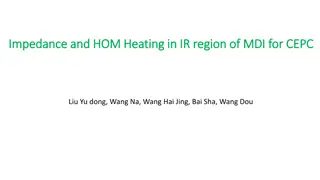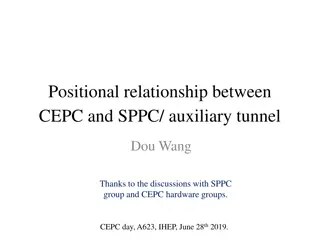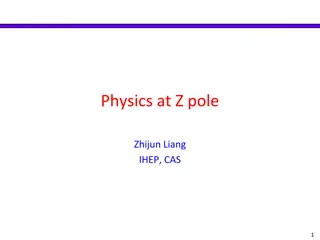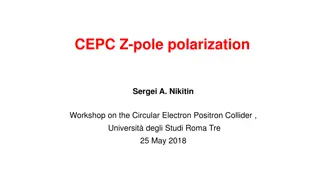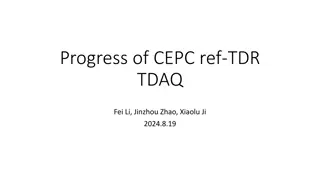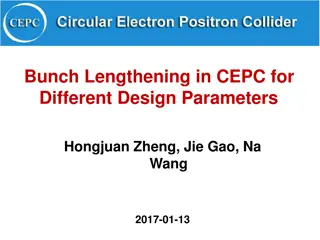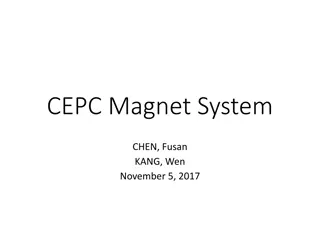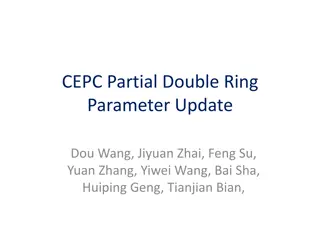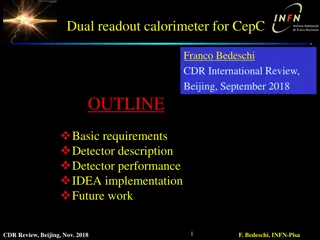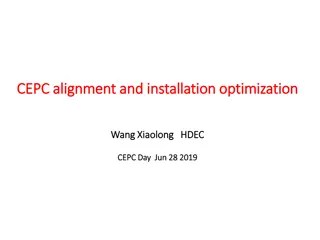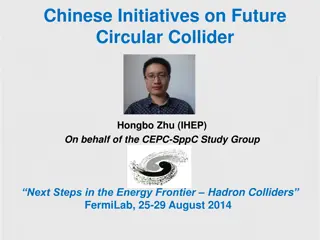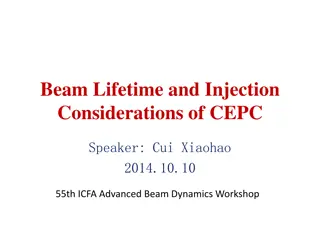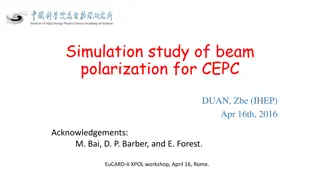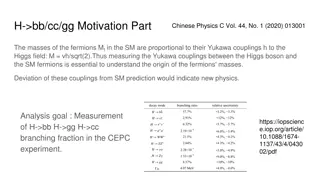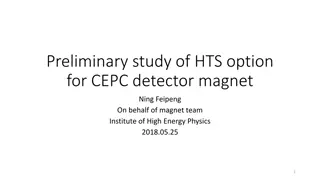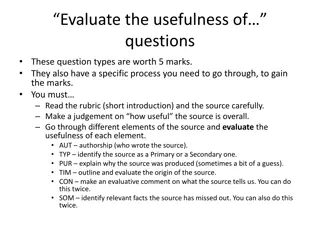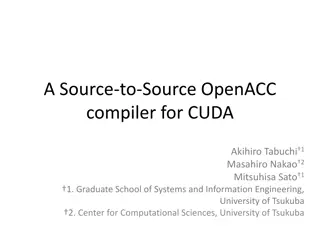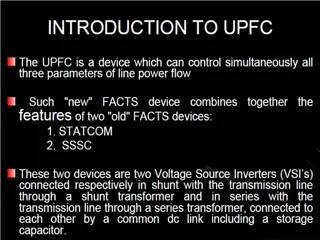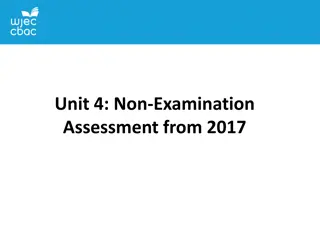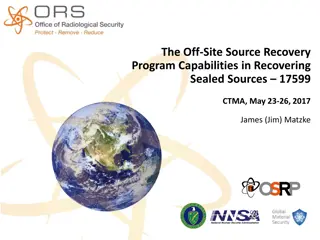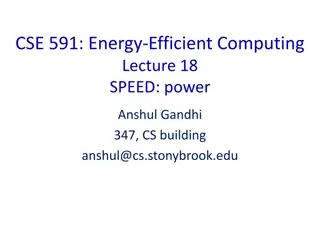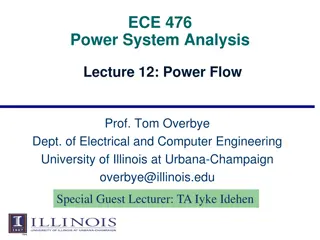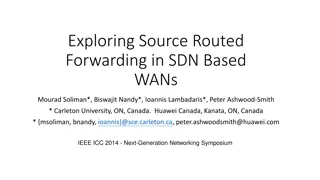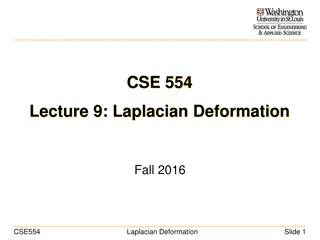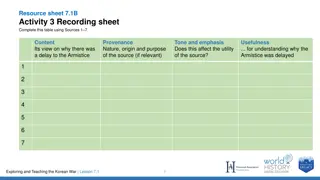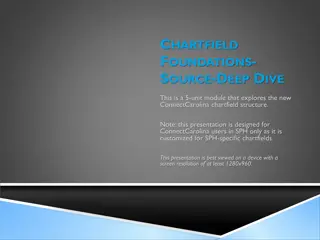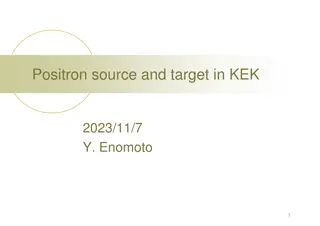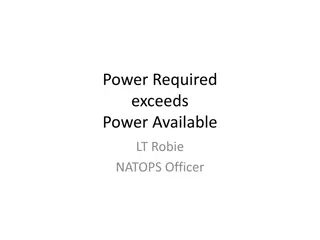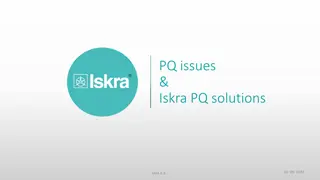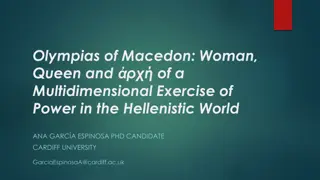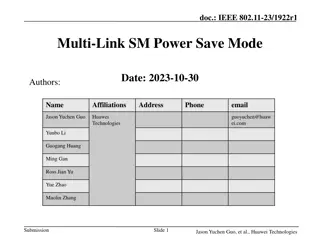CEPC RF Power Source Overview
The CEPC RF Power Source involves high-power RF sources for accelerating and stabilizing particles in the Collider system. It includes design elements, efficiency considerations, and operational cost impacts. The transmission system utilizes superconducting cavity technology to meet power demands effectively.
Download Presentation

Please find below an Image/Link to download the presentation.
The content on the website is provided AS IS for your information and personal use only. It may not be sold, licensed, or shared on other websites without obtaining consent from the author. Download presentation by click this link. If you encounter any issues during the download, it is possible that the publisher has removed the file from their server.
E N D
Presentation Transcript
CEPC RF Power source CEPC RF Power Source Zusheng ZHOU Jun. 29 2018, IHEP
CEPC RF Power source Contents Design a) Collider b) Booster c) Linac R&D Summary
CEPC RF Power source Design
CEPC RF Power source Collider Introduction a) High power RF sources are required to energy needed to accelerate particles or keep particles energy stable. Injector 10GeV Energy Ramp 10-45/120GeV Booster C=100km provide the Collider Ring C=100km Three rings in the same tunnel Collider & Booster SppC 45/120 GeV
CEPC RF Power source Collider Introduction b) The Collider beam power is more than 60 MW. The increase in efficiency of RF power sources is considered a high priority issue. RF power sources - efficiencies Tetrodes IOTs Klystrons SSA Magnetrons DC 400MHz (200 1500)MHz 300 MHz 1 GHz DC 20 GHz GHz range 1 MW 1.2 MW 1.5 MW < 1MW 85% - 90% (class C) 70% 65% 60% 90% Broadcasttechnology, widely discontinued Oscillator, not amplifier! Remark High power klystrons are the more attractive choice because of their high efficiency, low cost and more stable than IOT and SSA for CEPC collider.
CEPC RF Power source Collider Efficiency impact on operation cost (Only considering operation efficiency of klystrons) CEPC at 800 RMB/MWh and 6000 hours/year Excessive electricity bill, M RMB 700 Save Money 130M RMB 1 year 600 90 M RMB 500 400 300 200 100 0 40% 45% 50% 55% 60% 65% 70% 75% 80% 85% 90% 95% 100% NOW Efficiency, % COMING FUTURE
CEPC RF Power source Collider Transmission system Superconducting Cavity power demands Parameters Freq.(MHz) Cavity No. Value 650+/-0.5 240 300 Coupler input power(kW) Considering klystron lifetime, power redundancy and cost, the 2 cavities will be powered with one CW klystron capable to deliver more than 800 kW. RF Waveguide Distribution: Distribution of RF power (800kW) to the cavities (300kW), including waveguide, circulator and load. Other Auxiliary PS, Interlock and Controls, LLRF, Pre-amplifier.
CEPC RF Power source Collider Transmission system Schematic of the RF Transmission System (RFTS)
CEPC RF Power source Collider High efficiency klystron The vast majority of the existing commercial klystrons in the electronic efficiency range between 40 and 55 %. Only a few klystron available on the market are capable of operating with about 65 % efficiency or above. In a recent theoretical calculation conversion efficiency is achieved in CW klystron. Considering this recent high efficiency approach, our design goal is to achieve around 80% on saturation point. more than 80% RF power
CEPC RF Power source Collider High efficiency klystron CEPC Klystron Key Design Parameters Parameters Centre frequency Output power Efficiency(Goal) Units MHz kW % Values 650 0.5 800 80(70 linear) Another issue to consider is efficiency difference between saturation and linear region of the power transfer curve. So, for power consumption, we think efficiency is about 70% at the operating point. The high efficiency klystrons are not available from existed vendors. It will be developed in the world.
CEPC RF Power source Collider High efficiency klystron CEPC Collider SRF Wall Plug Efficiency Wall to PSM power supply/modulator 95% Modulator to klystron Klystron to waveguide Waveguide to coupler Coupler to cavity Cavity to beam Overall efficiency 96% 70% 95% ~100% ~100% ~60.6% The critical factor is klystron efficiency Much higher efficiency, less energy consumption.
CEPC RF Power source Collider PSM power supply PSM Design Parameters Parameters High voltage Current Module quantity Module voltage Module switch frequency Module number of redundancy Voltage stability Efficiency Turn-off time Stored energy Units Values kV A 120 15 168 800 1k 9 < 0.2 >95 <5 <15 V Hz % % us J Chinese company have successfully developed 80kV/18A PSM power supply for ADS project, so CEPC PSM and auxiliary equipment will also be provided by Chinese company.
CEPC RF Power source Collider Infrastructure Collider Power Source Gallery Klystron and transmission system are placed underground. PSM high voltage power supply and related auxiliary power supply are on the ground.
CEPC RF Power source Collider Infrastructure Collider RF Tunnel For space savings, transmission system in part are placed in RF tunnel.
CEPC RF Power source Booster Introduction The Booster RF system consists of 1.3 GHz superconducting RF cavities. There are 12 cryo-modules for Higgs operation, each containing eight 9-cell superconducting cavities. These cavities need 96 1300 MHz power sources.
CEPC RF Power source Booster Power source choice-SSA Their capabilities extend from a few kW to several hundred kW, and from less than 100 MHz to above 1 GHz. Reasonable efficiency (~50%), high gain, and modular design provide high reliability. High reliability for redundancy design, high flexibility for module design, high stability, low maintenance requirements, absence of warm-up time and low voltage operation and reasonable efficiency. So the SSA has been chosen for the Booster RF power source system.
CEPC RF Power source Booster Solid state amplifier 1.3 GHz/25kW SSA Specifications Parameters Frequency Power Gain Bandwidth (1dB) Amplitude stability Phase stability Phase Variation Harmonic Spurious Efficiency at 25kW MTBF Redundancy Values 1.3 GHz 25 kW 65 dB 1 MHz 0.1% RMS 0.1 RMS 10 < -30 dBc < -60 dBc 45% 30000 h 1 power module failure
CEPC RF Power source Booster RF transmission system There will be no power splitters or phase shifters in the Booster RFTS system, and the length differences as well as the thermal phase drifts will be easily tracked and compensated by the individual LLRF controls.
CEPC RF Power source Linac The main high power RF components are 75 units of 80 MW S- band klystrons and conventional solid state modulators. A waveguide system is used for power transmission from the klystrons to the accelerating structures, 75 klystrons are used to provide power for 288 accelerating structures. An RF window is used for vacuum isolation between the klystron and the waveguide transmission system. Modulator Klystron 80MW RF window Energy doubler Power divider load Accelerating structures
CEPC RF Power source R&D Plan and progress
CEPC RF Power source Plan & Progress Strategy and plan Goal 650MHz/800kW klystron meets CEPC project demands; Evaluation target: >80% efficiency(saturation point); 1st prototype development progress Beam dynamic, beam optic and cooling system; Mechanical design, infrastructure preparation; High efficiency consideration(2nd &3rd) Different method comparation; 3 kind of gun schemes; MBK
CEPC RF Power source Plan & Progress Mechanical design achieved (L Discussion on the manufacturing details being conducted W H: 5.12m 0.87m 1.56m)
CEPC RF Power source Plan & Progress 3 design schemes for high efficiency design Scheme 1 optimize cavity chain by using the same gun as 1st tube; Scheme 2 with high voltage gun (110kV/9.1A), low perveance; Scheme 3 MBK, 54kV/20A electron gun Parameter Freq (MHz) Voltage (kV) Current (A) Beam No. Perveance ( P) Efficency (%) Power(kW) Scheme1 650 81.5 15.1 1 0.65 >70 800 Scheme2 650 110 9.1 1 0.25 >80 800 Scheme3 650 54 20(2.5 8) 8 1.6(0.2 8) >80 800(100 8)
CEPC RF Power source Summary Design of RF power source for collider, booster and linac is showed; The increase in efficiency of RF power sources is considered a high priority issue; The first RF power source choice for booster is solid state amplifier; Development of high efficiency klystron is on going in China and other country; The manufacture of the 1st tube will be completed this year in China and 3 schemes for the high efficiency design are ongoing based on 3 different gun design.



